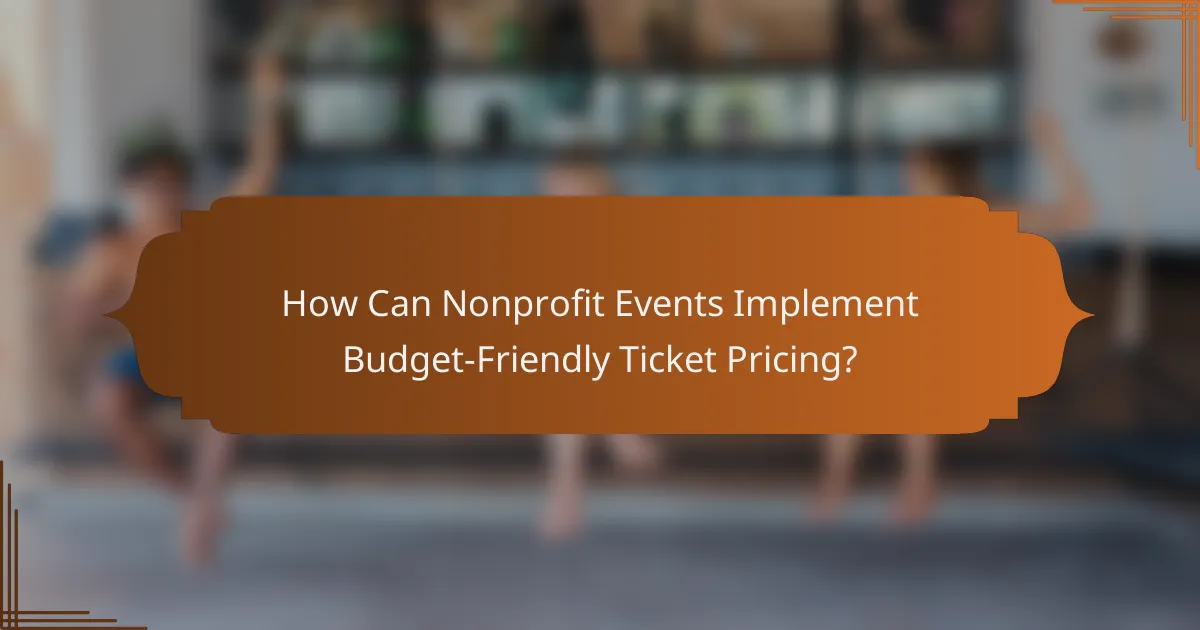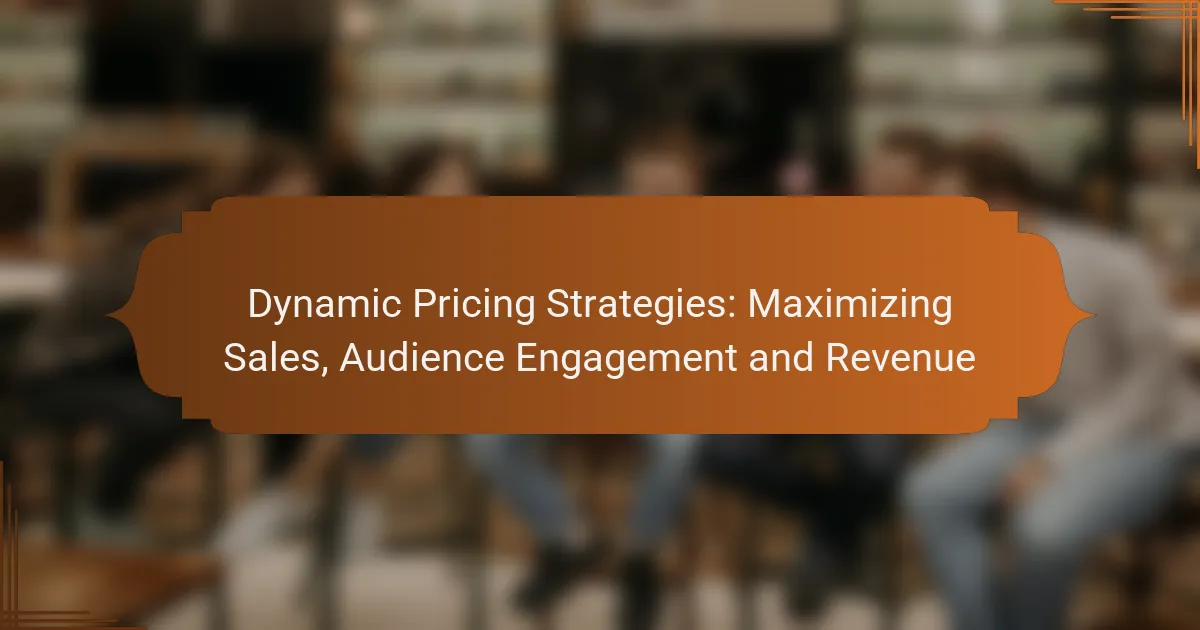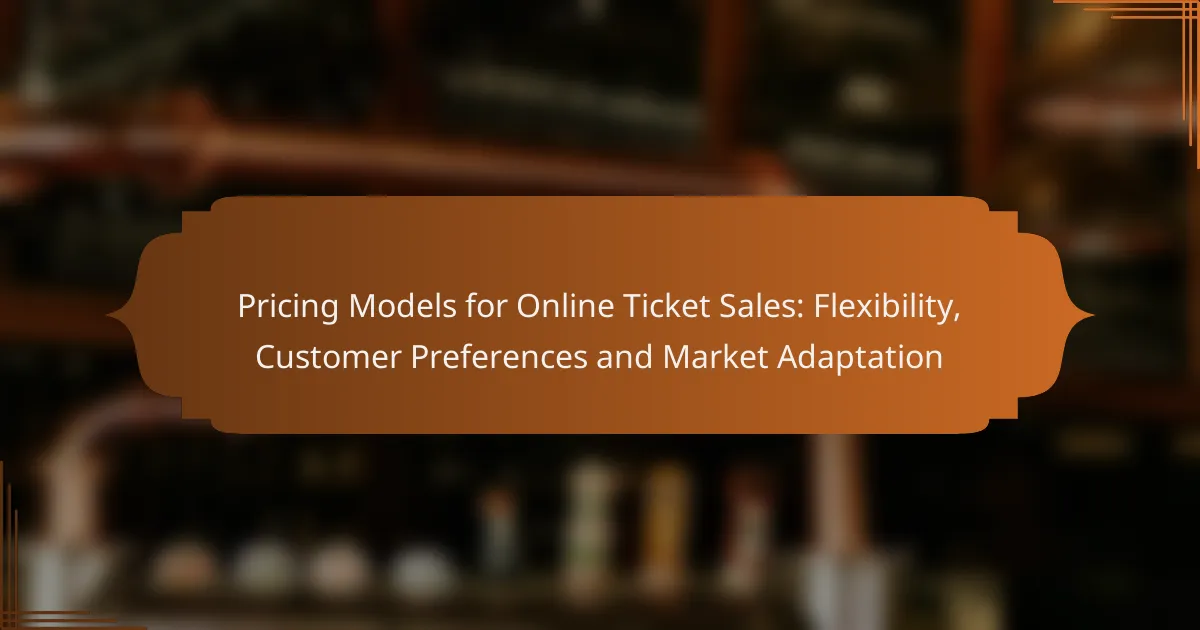Budget-friendly ticket pricing for nonprofit events is essential for making them accessible to a wider audience while still supporting the organization’s mission. By employing strategic pricing methods and incorporating accessibility features, nonprofits can foster greater community engagement and participation. These efforts not only enhance inclusivity but also strengthen the connection between the organization and the community it serves.

How Can Nonprofit Events Implement Budget-Friendly Ticket Pricing?
Nonprofit events can adopt budget-friendly ticket pricing by utilizing various strategies that make attendance more accessible while still generating necessary funds. These methods not only encourage participation but also enhance community engagement and support for the cause.
Tiered pricing models
Tiered pricing models allow organizations to offer different ticket prices based on the level of benefits or experiences provided. For instance, a basic ticket might grant entry, while higher tiers could include perks like VIP seating or exclusive access to speakers. This approach caters to various financial capabilities and encourages attendees to contribute at a level they feel comfortable with.
When implementing tiered pricing, consider the perceived value of each tier. Clearly communicate the benefits associated with each level to justify the price differences and motivate attendees to opt for higher tiers.
Early bird discounts
Early bird discounts incentivize attendees to purchase tickets well in advance, often at a reduced rate. This strategy not only boosts early sales but also helps nonprofits better forecast attendance and budget accordingly. A common practice is to offer discounts for tickets purchased several weeks or months before the event.
To maximize the effectiveness of early bird pricing, set clear deadlines and promote them through various channels, such as social media and newsletters. Ensure that the discount is significant enough to encourage early purchases without undermining the overall ticket revenue.
Group rates
Group rates provide discounted tickets for bulk purchases, making it more affordable for families, friends, or organizations to attend together. This pricing strategy can significantly increase overall attendance and foster a sense of community around the event. For example, offering a 10-20% discount for groups of ten or more can be an attractive incentive.
When promoting group rates, highlight the benefits of attending as a group, such as shared experiences and networking opportunities. Make the purchasing process straightforward to encourage larger groups to take advantage of the offer.
Sliding scale options
Sliding scale options allow attendees to pay what they can afford, based on their financial situation. This model is particularly effective for nonprofit events aiming to reach diverse audiences and ensure that financial barriers do not prevent participation. For instance, you might set a suggested price range and allow individuals to choose their ticket price within that range.
To implement sliding scale pricing effectively, provide clear guidelines on how to select a price. Consider including a brief questionnaire to help attendees assess their financial capacity, ensuring transparency and fairness in the process.

What Are Effective Strategies for Community Engagement?
Effective strategies for community engagement involve building relationships and fostering participation through various initiatives. These strategies can enhance accessibility and promote nonprofit events, ultimately leading to a stronger community connection.
Local partnerships
Establishing local partnerships can significantly enhance community engagement. Collaborating with schools, businesses, and other nonprofits allows for resource sharing and expanded outreach. For example, a local business might sponsor an event, providing financial support in exchange for promotional opportunities.
Consider forming alliances with community organizations that share similar goals. This can lead to joint events or initiatives that attract a wider audience and create a sense of shared purpose.
Volunteer involvement
Engaging volunteers is crucial for nonprofit events, as they can provide essential support and foster community spirit. Volunteers can help with event planning, logistics, and outreach efforts, making them invaluable to the success of any initiative.
To encourage volunteer participation, offer training sessions and recognize their contributions through appreciation events or certificates. This not only motivates volunteers but also strengthens their connection to the community and the organization.
Social media campaigns
Social media campaigns are a powerful tool for promoting community engagement. Utilizing platforms like Facebook, Instagram, and Twitter can help spread the word about events and initiatives, reaching a broader audience quickly and effectively.
When creating a social media campaign, focus on engaging content that encourages sharing and interaction. Use visuals, stories, and calls to action to inspire community members to participate and share their experiences, amplifying your reach organically.

How Do Accessibility Features Impact Ticket Pricing?
Accessibility features can significantly influence ticket pricing for nonprofit events by ensuring inclusivity while balancing costs. Implementing these features often requires additional resources, which can affect overall ticket prices but ultimately enhances community engagement.
Accessible venue selection
Choosing an accessible venue is crucial for accommodating individuals with disabilities. Venues that meet accessibility standards, such as those outlined in the Americans with Disabilities Act (ADA), may have higher rental costs, which can lead to increased ticket prices. Nonprofits should consider venues that offer essential features like ramps, elevators, and accessible restrooms to ensure all attendees can participate comfortably.
When selecting a venue, it’s beneficial to compare multiple locations. Look for venues that provide accessibility at no extra charge or those that offer discounts for nonprofit organizations. This can help keep ticket prices manageable while still meeting accessibility needs.
Discounts for caregivers
Offering discounts for caregivers can make events more accessible for individuals who require assistance. This approach not only encourages attendance but also acknowledges the important role caregivers play in supporting those with disabilities. Discounts can range from a percentage off the ticket price to free admission for caregivers accompanying a ticket holder.
Nonprofits should clearly communicate these discounts in their marketing materials. This transparency can enhance community trust and encourage more attendees, ultimately fostering a more inclusive environment.
Assistive technology availability
Providing assistive technology at events, such as hearing loops or captioning services, can enhance the experience for attendees with disabilities. While incorporating these technologies may involve upfront costs, they can significantly improve accessibility and engagement. Nonprofits should evaluate the specific needs of their audience to determine which technologies to offer.
Consider partnering with local organizations that specialize in assistive technology. This collaboration can help reduce costs and ensure that the necessary equipment is available, making events more inclusive without drastically increasing ticket prices.

What Are the Benefits of Budget-Friendly Ticket Pricing?
Budget-friendly ticket pricing offers significant advantages for nonprofit events, primarily by making them more accessible to a wider audience. This approach fosters community engagement and support, ultimately enhancing the event’s impact and reach.
Increased attendance
Lower ticket prices typically lead to increased attendance at nonprofit events. When costs are reduced, more individuals can participate, including those who may have financial constraints. This boost in numbers not only fills seats but also creates a more vibrant atmosphere.
To maximize attendance, consider offering tiered pricing or discounts for groups, students, or seniors. These strategies can further encourage participation from diverse demographics.
Enhanced community support
Budget-friendly ticket pricing strengthens community ties by allowing more residents to engage with local nonprofits. When events are affordable, they attract a broader spectrum of attendees, fostering a sense of belonging and shared purpose.
Engaging the community through accessible pricing can lead to increased volunteer support and donations. Attendees who feel welcomed are more likely to contribute their time or resources to future initiatives.
Broader audience reach
Offering budget-friendly tickets expands the audience reach of nonprofit events. By lowering financial barriers, organizations can attract individuals from various socioeconomic backgrounds, enhancing diversity and inclusivity.
To effectively reach a broader audience, utilize social media and local partnerships to promote events. Highlighting affordable ticket options can draw attention from those who may not typically attend such gatherings.

How Can Nonprofits Measure the Success of Their Pricing Strategies?
Nonprofits can measure the success of their pricing strategies by analyzing attendance metrics and gathering feedback through surveys. These methods provide insights into how pricing affects participation and community engagement.
Attendance metrics
Attendance metrics are crucial for evaluating the effectiveness of pricing strategies. By tracking the number of attendees at events, nonprofits can determine if their pricing is attracting the desired audience. For example, a significant increase in attendance following a price reduction may indicate that the previous pricing was a barrier for potential participants.
Nonprofits should also compare attendance across different events with varying price points. This can help identify optimal pricing ranges that maximize participation while still covering costs. A practical approach is to analyze attendance data over multiple events to spot trends and patterns.
Feedback surveys
Feedback surveys are an effective tool for understanding attendee perceptions regarding pricing. By asking participants about their thoughts on ticket prices, nonprofits can gauge whether the cost was a factor in their decision to attend. Surveys can include questions about perceived value and affordability, which can guide future pricing strategies.
To maximize response rates, nonprofits should keep surveys concise and offer incentives for completion, such as discounts on future events. Analyzing survey results can reveal common themes and help organizations adjust their pricing to better meet community needs, ensuring accessibility and engagement.



